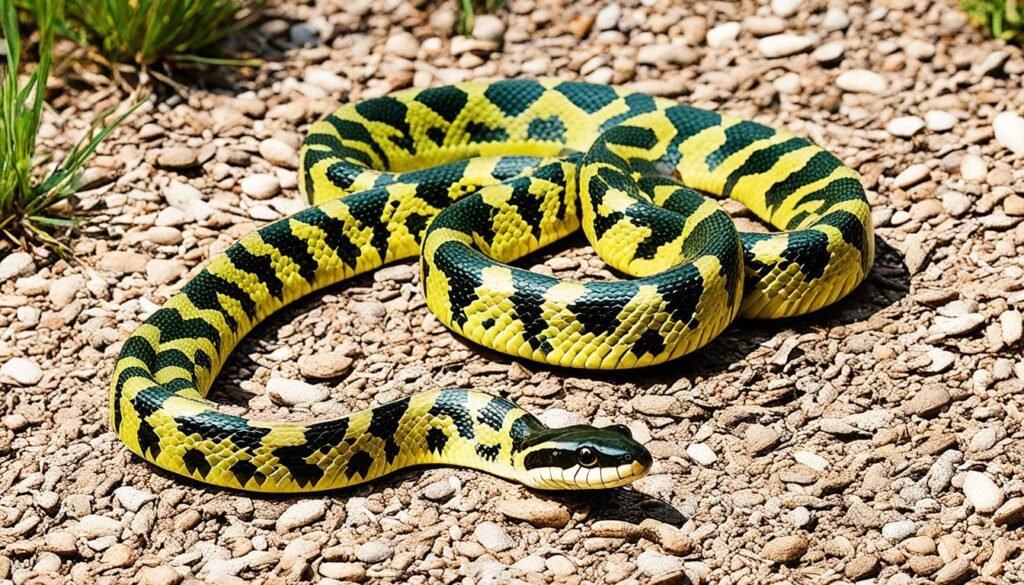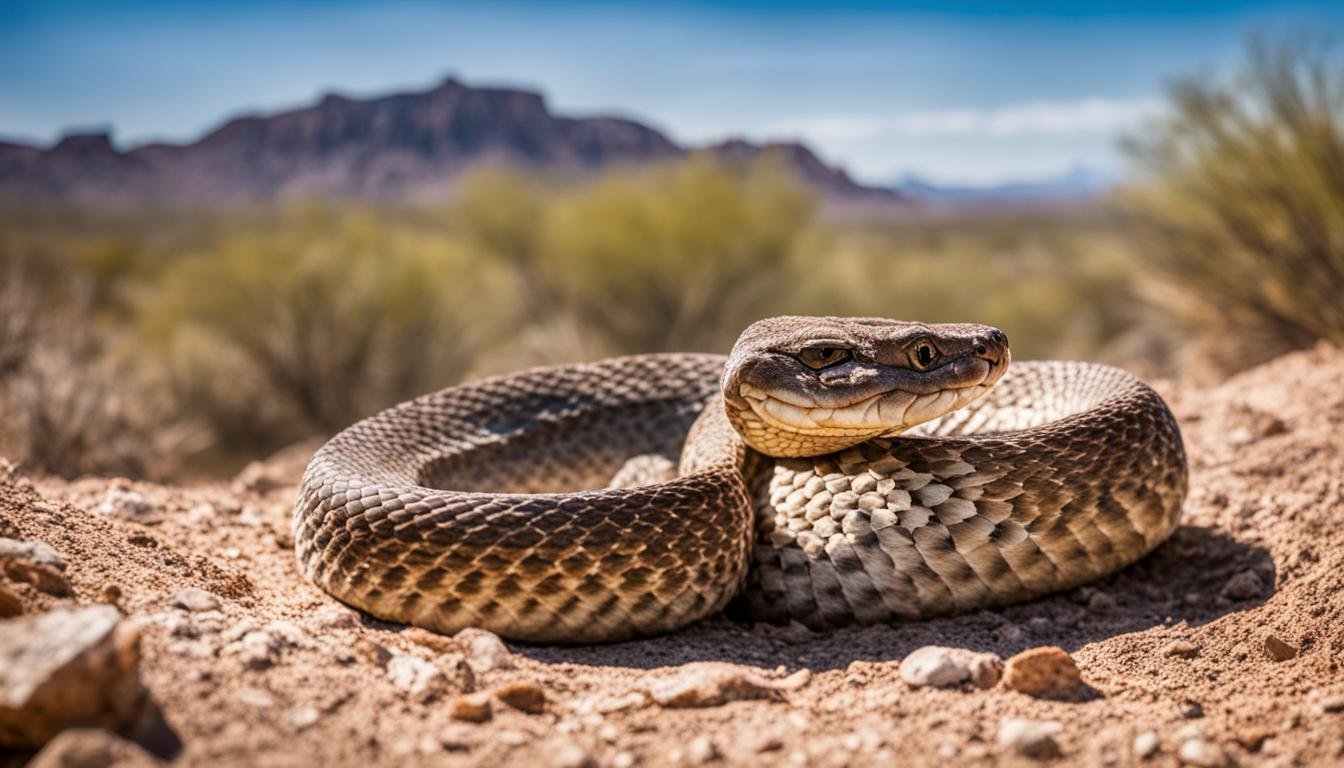Did you know that every year in the United States, an estimated 7,000 to 8,000 people are bitten by venomous snakes? And out of those, about 5 individuals tragically lose their lives due to snakebite. Rattlesnakes, one of the most notorious snake species, are responsible for a significant portion of these incidents. Whether you’re an outdoor enthusiast or simply want to learn more about these fascinating reptiles, understanding their behavior and taking necessary safety precautions is essential to ensure your well-being in snake country.
Key Takeaways:
- Rattlesnakes are responsible for an estimated 7,000 to 8,000 snakebites in the United States each year.
- About 5 individuals lose their lives annually due to rattlesnake bites.
- Understanding rattlesnake behavior and taking safety precautions is crucial for coexisting with these venomous snakes.
Rattlesnakes aren’t out to get humans
Rattlesnakes are fascinating creatures that are often misunderstood. Despite their reputation, these snakes are not out to get humans. As ambush predators, they lie in wait for their prey and do not actively chase after humans. Their primary targets are small mammals, and they prefer to remain hidden, getting close to their prey before striking.
When a rattlesnake encounters a human, its instinct is to flee rather than attack. However, if it feels threatened or cornered, it may coil up and rattle as a warning. It’s important to give rattlesnakes space and avoid provoking them, as this can minimize the risk of a bite.
Remember, rattlesnakes are ambush predators and prefer to avoid confrontation with humans. They only strike if they feel threatened.
Rattlesnake Behavior and Avoidance Tips
- Stay on designated trails: Rattlesnakes are more likely to be found in rocky areas, so sticking to established paths can reduce the chance of encountering them.
- Watch where you step: Keep an eye on the ground and be cautious when walking in areas with dense vegetation.
- Use a flashlight at night: If you’re hiking or exploring at night, carry a flashlight to increase visibility and spot any rattlesnakes in your path.
- Don’t approach or provoke: Never attempt to handle or agitate a rattlesnake, as this increases the risk of a bite.
Rattlesnake Bite: What to Do
While it’s essential to take precautions to avoid rattlesnake bites, accidents can still happen. If you or someone you know is bitten by a rattlesnake, follow these steps:
- Stay calm: Panicking can increase heart rate and spread the venom more quickly.
- Seek medical attention: Call emergency services or go to the nearest hospital immediately. Medical professionals can provide the necessary treatment.
- Avoid restricting blood flow: Do not apply a tourniquet or attempt to cut off blood flow, as this can do more harm than good.
- Do not suck out the venom: Contrary to popular belief, using your mouth to remove venom is ineffective and can introduce bacteria to the wound.
| Signs of a rattlesnake bite | Immediate actions |
|---|---|
| Pain or burning at the bite site | Stay calm and seek medical attention immediately |
| Visible fang marks | Do not attempt to remove venom; transport the victim to a medical facility |
| Metallic or rubbery taste | Keep the affected area immobilized and below heart level, if possible |
| Swelling and potential symptoms like chills, nausea, and vomiting | Do not apply ice or use suction devices; rely on medical professionals’ expertise |
Remember, early medical intervention is crucial in minimizing the effects of a rattlesnake bite.
Baby rattlesnakes aren’t any more or less dangerous
Contrary to popular belief, baby rattlesnakes are not more dangerous than adults. Research has shown that juvenile rattlesnakes can regulate the amount of venom they produce and have a smaller volume of venom compared to larger snakes. This regulation of venom production allows them to control the potency of their bites, reducing the severity of envenomation.
The severity of a rattlesnake bite depends on various factors, including the type of snake, the circumstances of the bite, and the individual’s biology and medical history. It’s crucial to seek immediate medical treatment regardless of the age of the snake. Only through proper medical evaluation and treatment can the severity of the bite be determined and appropriate measures be taken to mitigate potential complications.
Rattlesnake bites can be serious medical emergencies, and prompt medical attention is essential. Medical professionals can assess the severity of the bite, administer appropriate antivenom, and provide supportive care to manage symptoms and prevent complications. Delaying or avoiding medical treatment can lead to further complications and worsen the overall outcome.
You may not always hear a rattle before a strike
While rattlesnakes are known for their distinctive rattling sound, not all rattlesnakes will rattle before striking. The decision to rattle is based on the snake’s assessment of the threat, and some snakes may choose to remain silent and rely on their camouflage instead. Additionally, baby rattlesnakes may not have fully developed rattles or may have lost their rattles through shedding or damage. Therefore, it’s important to be cautious and assume that a rattlesnake may be present even if you don’t hear a rattle.
Defensive Behavior
- Rattlesnakes use their rattles as a warning signal to deter potential threats.
- However, some rattlesnakes may choose not to rattle, relying on their camouflage instead.
- They may perceive the environment as low risk and prefer to remain silent.
Rattlesnake Behaviors
- Baby rattlesnakes may not have fully developed rattles or may have lost them through shedding or damage.
- Not all rattlesnakes will rattle before striking, depending on their assessment of the threat.
- Assume that a rattlesnake may be present even if you don’t hear a rattle.
Know how to spot a rattlesnake

Identifying a rattlesnake can be crucial in avoiding encounters. Rattlesnakes have distinctive features that can help you recognize them in their habitat.
Visual Cues:
- Elliptical Eyes: Rattlesnakes have vertically elliptical pupils, similar to a cat’s eyes. This characteristic sets them apart from non-venomous snakes, which have round pupils.
- Heat-Sensing Pits: Look for well-defined heat-sensing pits located on each side of the rattlesnake’s head, just below the nostrils. These pits help them detect warm-blooded prey, such as rodents, in their surroundings.
- Diamond-Shaped Pattern: Rattlesnakes typically have a diamond-shaped pattern on their backs, formed by a series of darker patches on a lighter background. However, keep in mind that coloration may vary among different species and individuals.
Habitat:
Rattlesnakes prefer rocky crevices and areas with dense vegetation, such as patios, brush, or wood piles, where they can hide and stay concealed. They are particularly prevalent in the southwestern regions of the United States, including Arizona, California, and New Mexico.
| Feature | Characteristic |
|---|---|
| Eye Shape | Elliptical |
| Heat-Sensing Pits | Well-defined, below nostrils |
| Back Pattern | Diamond-shaped, varied colors |
| Habitat | Rocky crevices, dense vegetation |
Being able to recognize these visual cues and understand their preferred habitats can help you stay safe and take appropriate precautions when spending time outdoors.
You’ll know if you’ve been bitten
If you find yourself bitten by a rattlesnake, there are several symptoms you might experience. These include immediate pain or burning at the site of the bite, visible fang marks, and a metallic or rubbery taste in your mouth. You may also notice significant swelling around the bite area, along with potential symptoms such as chills, nausea, and vomiting.
The venom from a rattlesnake bite can cause tissue damage and thin the blood, leading to complications if left untreated. Therefore, it is crucial to seek immediate medical attention, even if you don’t immediately experience these symptoms. Medical professionals can assess the severity of the bite and provide appropriate treatment.
Do not attempt to remove the venom yourself or apply ice or tourniquets, as these measures can worsen the situation. It’s important to allow trained medical professionals to handle the treatment, as they have the expertise and resources to administer antivenom effectively.
| Rattlesnake Bite Symptoms | |
|---|---|
| Pain or burning at the bite site | Visible fang marks |
| Metallic or rubbery taste in the mouth | Significant swelling around the bite area |
| Chills, nausea, and vomiting |
Can you prevent a snake bite from happening?

While it’s impossible to completely eliminate the risk of encountering a rattlesnake, there are steps you can take to lower the chances of a snake bite. Being aware of snake bite prevention measures and practicing outdoor safety can greatly reduce the likelihood of a dangerous encounter. Here are some hiking precautions and tips to keep in mind:
- Wear appropriate footwear: When hiking in areas known for rattlesnake activity, choose closed-toe shoes or boots to protect your feet from potential snake bites. Avoid sandals or open-toe shoes that leave your feet exposed.
- Stay on designated trails: Stick to established trails and avoid venturing into tall grass, heavy underbrush, or rocky areas where snakes may be hiding. Stick to well-maintained paths to minimize the chances of accidental encounters.
- Be cautious of where you place your hands: When exploring rocks, fallen logs, or debris, ensure you can see where you’re placing your hands. Snakes may be hiding in these areas, so exercise caution and use a stick or hiking pole to clear away any potential hiding spots.
- Avoid tall grass and heavy underbrush: Rattlesnakes often seek shelter in tall grass and thick vegetation, so be mindful of your surroundings and steer clear of these areas during your hike.
- Do not attempt to handle or approach a snake: Even if you encounter a snake from a distance, it’s essential to avoid any interaction or attempt to handle the snake. Keep a safe distance and observe the snake from afar.
By following these hiking precautions and being aware of snake bite prevention strategies, you can minimize the risk of snake bites during your outdoor adventures. Remember to always exercise caution, respect the natural habitat of rattlesnakes, and enjoy the outdoors safely.
Helping prevent rattlesnake encounters with dogs
When exploring areas known for rattlesnakes, it’s important to consider the safety of your furry friend. Dogs can be at risk for rattlesnake encounters, especially if they are off-leash. By taking a few precautions, you can help prevent potential snake bites and ensure the well-being of your canine companion.
- Keep Your Dog on a Leash: While hiking and exploring snake-prone areas, always keep your dog on a leash. This not only allows you to maintain control but also reduces the risk of your dog unintentionally provoking a snake.
- Be Mindful of Leash Regulations: Familiarize yourself with local leash regulations and adhere to them. These regulations are in place to protect the safety of both wildlife and pets. Keep your dog on a leash at all times, unless you are in designated off-leash areas where it is safe and permitted.
- Consider Rattlesnake Aversion Training: Rattlesnake aversion training is a specialized program that can help teach your dog to avoid rattlesnakes. During this training, dogs are exposed to the sight, sound, and smell of a rattlesnake in a controlled environment. This can instill a natural aversion in dogs, discouraging them from approaching or engaging with rattlesnakes.
- Seek Veterinary Attention: In the unfortunate event that your dog is bitten by a rattlesnake, it’s crucial to seek veterinary attention immediately. Venomous snakebites can be life-threatening to dogs, and prompt medical treatment, including antivenom administration, is essential for their recovery.
Conclusion
Rattlesnakes are a vital component of many ecosystems, as they help control rodent populations. To ensure your safety while coexisting with wildlife, it’s essential to have a good understanding of rattlesnake behavior and take necessary precautions when engaging in outdoor activities.
When encountering a rattlesnake, remain calm and maintain a safe distance. Remember that they are not aggressively seeking out humans and will generally choose to flee rather than attack. If unfortunate enough to be bitten, seek immediate medical attention, as proper medical treatment is crucial for a positive outcome.
To coexist peacefully with rattlesnakes and other wildlife, always respect their natural habitat. Be aware of your surroundings, stay on designated trails, and avoid tall grass and heavy underbrush. Additionally, keeping your pets on a leash and considering rattlesnake aversion training can help prevent snake encounters and protect your furry companions.
By practicing rattlesnake safety and maintaining outdoor awareness, you can enjoy the beauty of nature while minimizing potential conflicts. Remember, it’s our responsibility to protect ourselves, respect wildlife, and promote a harmonious coexistence between humans and these fascinating reptiles.


7 thoughts on “Understanding Rattlesnake Behavior and Safety”